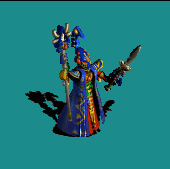What do you mean your dog ate the reinforcements?
Can you remember what you did before you got bitten by the computer game bug?
I can; I played tabletop miniatures games, like Battletech and Space Marines.
I painstakingly painted those little metal figurines just so I could get together
with my buddies on the weekends to drink a lot of soda, roll some dice, and mark
up some stat sheets. But, the age of the computer came, and processors started
to run faster than a production-stock Urbanmech (you DO know how many movement
points an Urbanmech has, right?). Activision’s Mechwarrior and Mechwarrior
II came out, taking FASA’s knock-off of Japanese mecha combat out of the hex-based
universe and into its first-person glory. SSI’s Warhammer 40,000: Rites of
War does just the opposite, taking the tape-measured tabletop game and sticking
it over chickenwire, completely removing the third dimension.
Rites of War, SSI’s second Warhammer 40K game, lets players assume
the role of the powerful and mysterious Eldar, the remnants of an ancient race
that used to control most of the known universe. Unfortunately, the gods of
chaos tore the Eldar empire asunder and left them to wander the stars in large
ships known as Craftworlds, seeking to regain their forgotten glory. As the
game begins, your scouts have located a planet that is actually a rare Maidenworld:
a planet the Eldar terraformed long ago but had to abandon when chaos reigned.
This world of Davinuus is a rare jewel indeed, for it is also home to many ancient
relics that may help your cause.
However, a vermin called Man currently populates Davinuus, and humans are quite xenophobic. In fact, your initial surveyors and scouts (who were on a peaceful mission to reclaim the artifacts that rightfully belong to the Eldar) were immediately fired upon. And so begins Rites of War, with your troops under fire and on the run. Eventually, a race of semi-intelligent space creatures intent on eating the universe, known as the Tyranids, makes its appearance, proving that games can rarely be considered a question of us versus them.
Can Rites of War recreate the atmosphere of the old Game Workshop tabletop? Frankly, no, but it can come close. The graphics in the game are nice and large, with all the cool multicolored Jesters, Harlequins, Warlocks, and anti-grav tanks you could never paint carefully enough. And, this time, they come animated and with kung-fu grip!
The music is bearable and not overly annoying. The sound effects are none too impressive, though I have to mention the great job they did on those blood-curdling death screams. There’s just something about seeing and hearing some hapless Space Marine get mowed down by your Striking Scorpion’s chainsaw that makes it all worthwhile.
There are, as is usual in most games of this genre, three ways to play Rites of War: as a campaign, as a skirmish versus the computer, and as a multiplayer game versus your friends. Though Rites of War bills itself as a turn-based strategy game, the campaign setting plays much like a Dungeons and Dragons-style RPG. Once you choose the units you want for your initial army, you may continue to use them in future scenarios. The more you use them, the more experience and glory points they earn, which you can use to purchase bigger and better units.

What’s more, the more experience and levels a unit has, the better skills it
receives. After a while, most units (except war machines and artillery) get
to graduate and change into their more advanced forms. The basic Guardian unit,
after four levels of experience, may become a Fire Dragon support unit, and,
after four more levels of experience, may opt to become a Fire Dragon Exarch.
The advancement process encourages unit conservation and diversification, if
only for the excitement seeing them advance and succeed.
The computer opponent isn’t particularly bright and relies on the age-old tactic of swarming you with massive amounts of fast and lethal units. Opposing armies tend to be heavy on the mechanized side, so loading up on armor-piercing units and support fire is never a bad idea. In the stand-alone scenarios where glory points are a more limiting factor, the AI did manage to throw some interesting tricks into the mix, but overall the attack pattern became somewhat predictable.
One drawback of the campaign scenario is that you can only play as the Eldar. Considering the existence of some other space wargame out there that features humans versus ancient-powerful-psychic-race versus biological-death-creatures (hmmm, what could I be talking about?), and the fact that it offers three different campaigns from each race’s point of view, the limitation of only one playable race in Rites of War was kind of a letdown. The availability of playing all three races (even mixed!) in multiplayer only partially makes up for this obvious oversight.
So I ask again, to nobody in particular: Can Rites of War replace the old-school Warhammer 40K? Sure, if you can do without the camraderie of a living room full of unwashed and caffinated guys arguing whether that shot should have gone 15 or 16 cm. (I can live without that. – Ed.) And hey, you’ll never run the danger of sitting on a your brother’s Brightlance again.

-
Glory Advancement System
-
Nostalgia
-
Only One Playable Race







